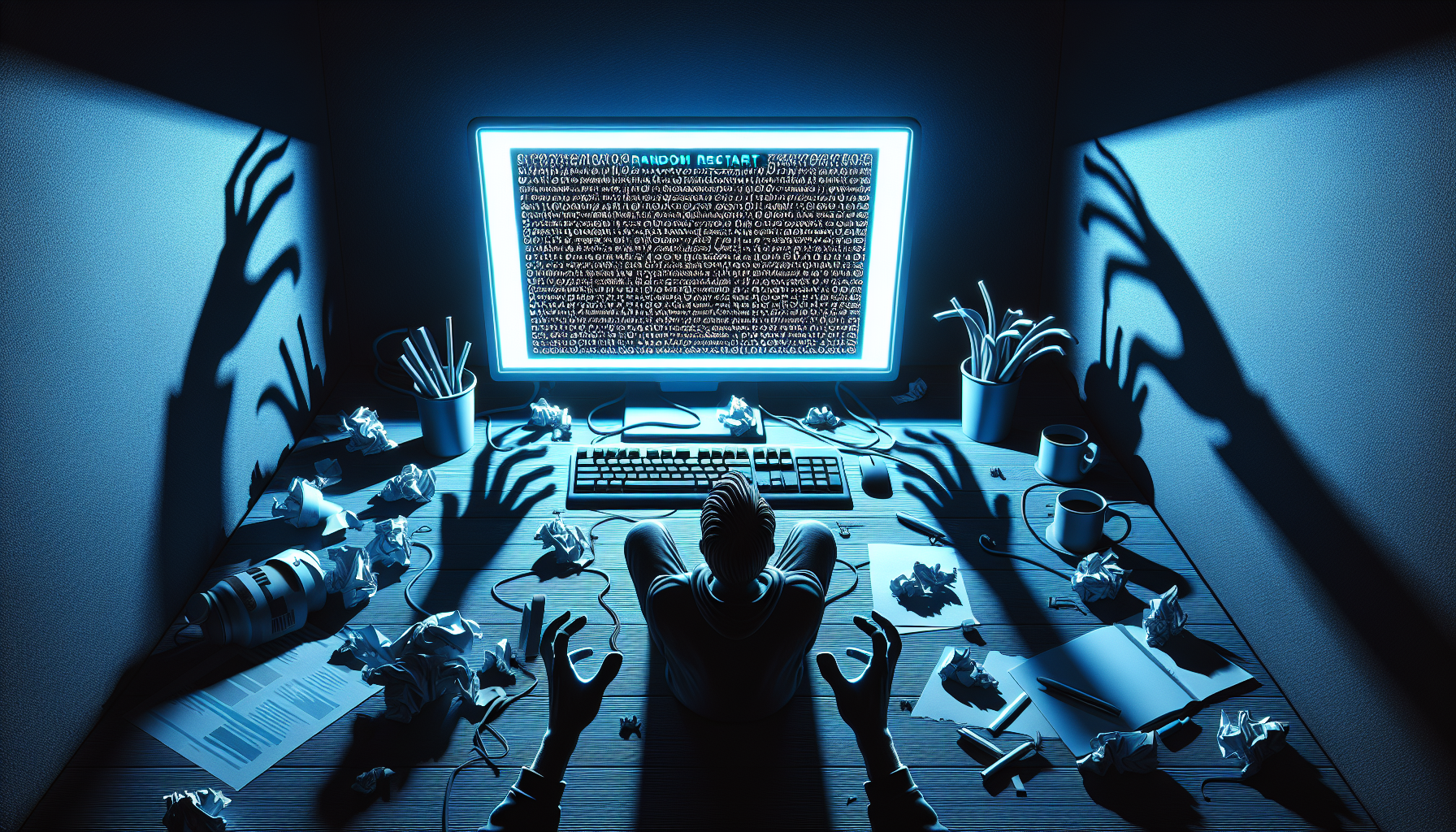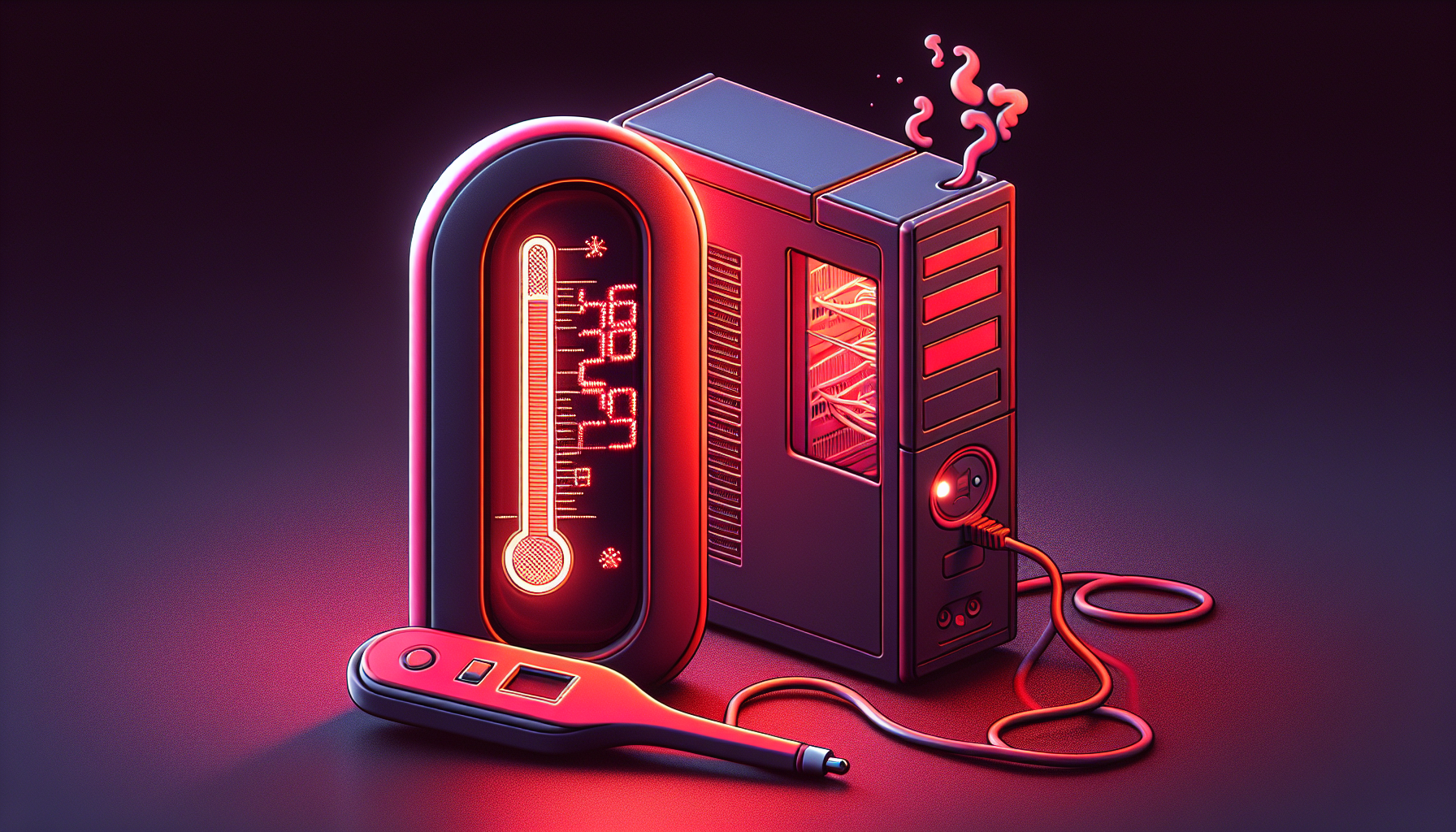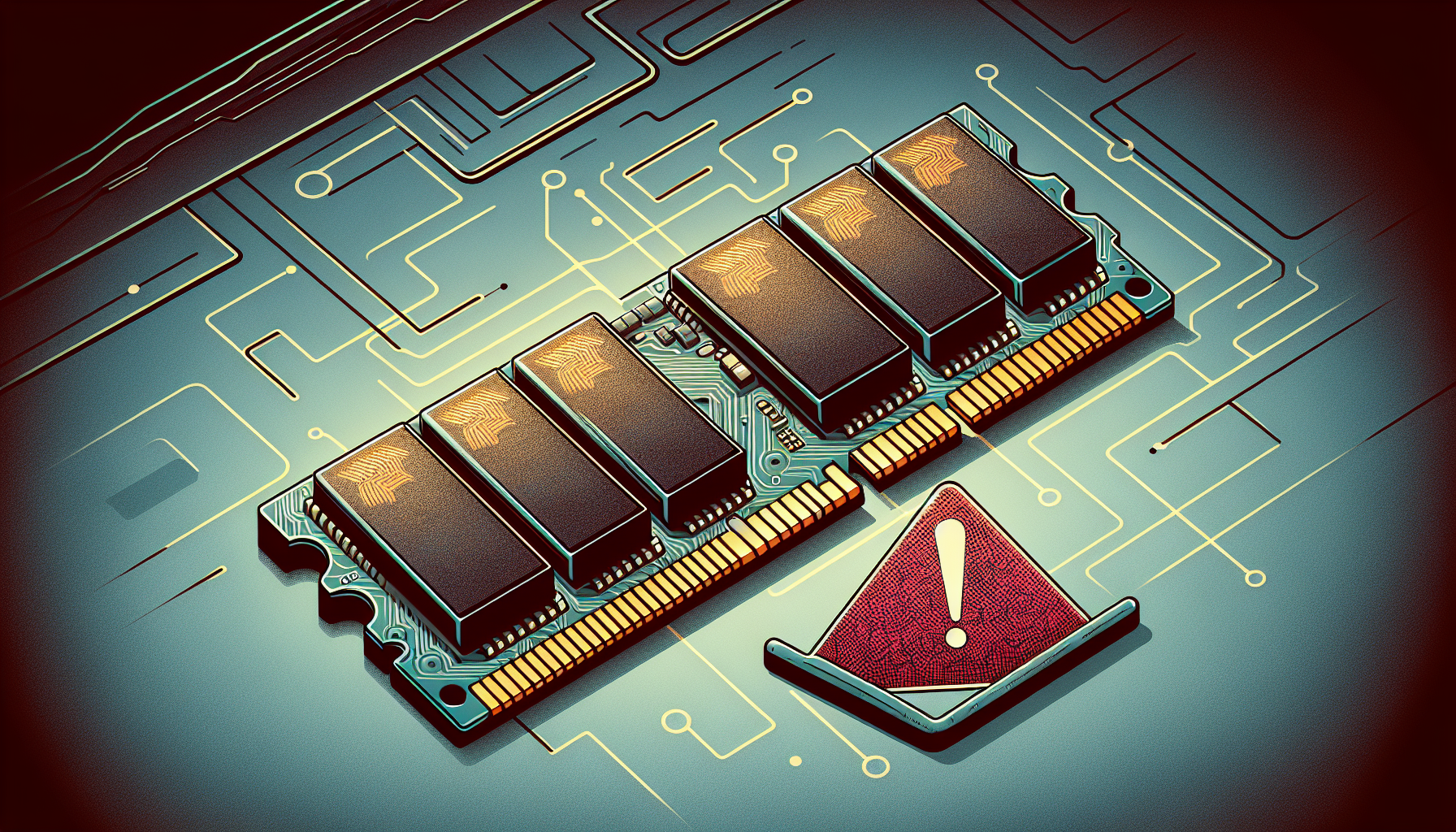At our repair shop, a common concern among our patrons is when their “computer randomly restarts,” leading to unexpected disruptions and understandable frustration. If you’re currently facing this problem it’s natural to want answers and effective solutions.
In this article, we cover the potential causes—from system failures and overheating to power supply and hardware issues—and offer actionable steps to diagnose and fix the problem of your computer randomly restarting.
Keep reading to troubleshoot and restore stability to your system when your computer randomly restarts.
Key Takeaways
- Random restarts can be caused by power supply issues, overheating, faulty hardware including RAM, driver problems, software conflicts, system failures like the Blue Screen of Death, and automatic system recovery settings.
- To diagnose and fix the problem of random restarts, a systematic approach should be taken, including using the Windows Memory Diagnostic tool for RAM issues, updating drivers and operating system, disabling automatic restart, checking the power supply, monitoring for overheating, and resolving software conflicts.
- Regular computer maintenance, such as updating BIOS, running system scans for malware, physically cleaning the computer, and managing software updates, can help prevent random restarts and maintain overall system health.
Understanding why your computer randomly restarts

Random restarts are not only inconvenient but can also lead to significant data loss, adding to your list of frustrations. Your PC might experience a computer randomly restart for various reasons, including:
- System failures such as the infamous Blue Screen of Death
- Overheating issues
- Hardware or driver problems
- Power supply issues, which may cause your computer to randomly restart
- Software conflicts
In some cases, the restart may happen unexpectedly and restart automatically without an error message, leaving you in the dark about the cause.
The triggers of these restarts are diverse and can include:
- Faulty hardware
- Software issues
- Inadequate ventilation
- System instability
- Software conflicts
Understanding these causes is the first step in resolving the pc randomly restarts issue.
Diagnosing Power Supply Problems
The power supply unit (PSU) is the heartbeat of your system, pumping life into all hardware components. An unstable or faulty PSU can be a prime suspect when your computer restarts randomly. A power supply tester can be a handy tool to check if your PSU is delivering adequate power and determine if a replacement is necessary.
If power issues persist after thorough testing, consider replacing your desktop PC’s power supply, a new PSU can breathe fresh life into your system and potentially fix random restarts. It’s crucial to ensure that the PSU has the capacity to handle high-demand situations and is in good health to maintain system stability.
Navigating Advanced System Settings
You might have noticed that your PC restarts automatically after a system failure. This automatic restart feature, while designed to recover from failures, can be a hindrance when troubleshooting as errors are not displayed. To prevent this, you can disable the automatic restart feature.
To disable automatic restart on your PC, follow these steps:
- Navigate to ‘System Properties’ via the Control Panel.
- Access ‘Startup and Recovery’ settings.
- Find the option to disable automatic restart.
- Uncheck the box next to ‘Automatically restart’ in the system settings.
This will prevent your PC from restarting without warning after a failure.
Assessing Overheating Issues

Is your PC experiencing any of the following issues?
- Running slower than usual
- Making louder fan noise
- Experiencing automatic shutdowns
- Having reduced CPU frequency
- Experiencing throttling
- Random restarts
These could be symptoms of an overheating computer.
Overclocking hardware components such as the CPU and GPU can lead to overheating and potentially cause your computer to restart randomly. Monitoring internal temperatures using software tools can assist in early detection of overheating and prevent forced shutdowns.
Checking for Faulty RAM

Random Access Memory (RAM) plays a crucial role in system performance and stability. Faulty RAM can lead to a variety of issues including the dreaded random restarts. To diagnose RAM issues, you can use the Windows Memory Diagnostic tool.
Start by running the system memory diagnostics tool from the Start menu, and upon restarting your computer, select the level of testing rigor from Basic, Standard, or Extended modes using the F1 key. After the memory test is complete, retrieve the results through the Event Viewer by navigating to Windows Logs and selecting the ‘MemoryDiagnostic’ entry.
If problems with RAM are detected, an error message will display with information that may identify the defective module, at which point the faulty RAM should be replaced to enhance system stability.
For an alternative RAM assessment, use Memtest86+ via a USB drive, which allows for memory testing outside of the operating system environment.
Updating Drivers and Operating System

Keeping your drivers and operating system up-to-date is critical for a smooth and stable computing experience. Outdated drivers can create compatibility issues or decrease computer performance, contributing to random restarts.
Updating drivers ensures compatibility and provides the latest versions, potentially resolving random restart issues.
Graphics Card Driver Updates
Your graphics card plays a crucial role in your PC’s performance. Having the latest drivers for your graphics card is essential for ensuring optimal performance and avoiding issues like random restarts. The first step is to determine your graphics card model, which can be found in the Adapter Type section of the graphics card properties, accessed from the Screen Resolution settings window.
Once you have identified your graphics card model, obtain the latest drivers from the manufacturer’s official website by following these steps:
- Select the specific model or series of your graphics card.
- Download the driver for your operating system.
- Make sure to avoid downloading drivers from third-party sites to avoid malware risks.
If the driver isn’t found through automatic detection on the manufacturer’s website, you can manually select the graphics card model and operating system to find the right driver.
Operating System Patches
When it comes to maintaining system stability and resolving software-related causes for computer restarting randomly, installing the latest Windows updates on your Windows PC can be a game-changer. You can check for and install Windows updates by accessing the Settings app and navigating to the ‘Update & Security’ section.
However, it’s not always sunshine and rainbows with updates. Sometimes, Windows Updates can cause the operating system to malfunction. In such cases, you can uninstall the recent updates one at a time to observe which update may be causing the issue.
Tackling Software Conflicts
Software conflicts can be quite a headache, leading to system instability and random restarts. Uninstalling recently installed applications can resolve these conflicts and bring back system stability.
To identify and manage software conflicts, you can use the System Configuration tool and third-party applications like Autoruns and Process Explorer. These tools provide insights into startup programs and running processes. System Restore can also be a useful tool, rolling the computer’s system software back to a previous state to eliminate software conflicts introduced thereafter.
BIOS Update Procedures
The Basic Input/Output System (BIOS) forms a critical component of your system, controlling the hardware at a fundamental level. An outdated BIOS can cause compatibility issues with hardware and software, triggering random restarts. Hence, updating BIOS is crucial.
Before updating the BIOS, follow these steps:
- Back up your data to prevent any loss.
- Ensure a stable power supply to prevent any update interruptions.
- Identify the correct BIOS file from the manufacturer’s website.
- Use a BIOS update utility in the BIOS setup.
- Follow the instructions precisely to complete the update.
Event Viewer Insights
The Event Viewer is a powerful built-in tool that helps you investigate issues linked to random restarts. By navigating to Windows logs, then selecting System, you can review error messages and find potential causes for system instability.
Looking for minidump files or by saving and reviewing system event logs for specific error messages can help diagnose the causes of random restarts. For instance, WHEA-Logger Event ID 18 signals critical hardware problems. This tool can also help track down software conflicts by detailing the software involved in the conflict.
Safe Mode Exploration
Safe Mode is a diagnostic mode of a computer operating system that starts Windows with a minimal set of drivers and services. It’s a useful tool for troubleshooting potential system issues.
Boot into Safe Mode only for troubleshooting and fixing issues. Safe Mode with Networking enables installation of drivers which might be needed to resolve some issues.
After troubleshooting in Safe Mode, restart the device to return to normal mode. If the device continues to start in Safe Mode, uncheck the ‘Safe boot’ option in the System Configuration tool under the Boot tab.
Preventative Measures for System Health

Prevention is better than cure, and this holds true for maintaining system health as well. Regular PC maintenance, including BIOS updates, scanning for malware, and preventive physical measures, can significantly reduce the risk of random restarts.
Regular system scans for malware are vital for ensuring your computer system is not compromised, leading to random restarts. Physical measures such as cleaning the PC’s internals, securing connections, and keeping power and restart buttons unobstructed reduce the risk of overheating and accidental restarts.
Summary
In conclusion, while random restarts can be quite a bother, understanding the causes and implementing the right fixes can help mitigate these issues. From diagnosing power supply problems and managing software conflicts to updating drivers and BIOS, each step contributes to a smoother and more stable computing experience. Remember, regular PC maintenance goes a long way in preventing such issues. So, take charge of your system health today and enjoy a seamless computing experience.
Frequently Asked Questions
What would cause a computer to restart randomly?
A computer may restart randomly due to overheating, dirty fans, faulty power supply, malware issues, driver difficulties, or malfunctioning automatic restarting feature.
Can a bad CPU cause random restarts?
Yes, a bad CPU can cause random restarts, as overheating and system disruptions can trigger safety protocols leading to reboots. Proper diagnostics can help identify the exact cause.
Why does computer restarts without warning?
Your computer may restart without warning due to various reasons such as system hardware failures, overheating, shutdown problems, or a flawed Windows update.
How do you fix PC keeps restarting by itself?
To fix your PC that keeps restarting by itself, start by checking for overheating and dust buildup. Then, consider running a memory diagnostic and updating any outdated software or drivers. Additionally, you can disable automatic restart, fast startup, and uninstall recent updates or apps as troubleshooting steps. Remember to check for driver updates as well.
How can I diagnose power supply problems?
To diagnose power supply problems, start by checking the connection of your PC’s power cord and the power outlet. Consider using a power supply tester to ensure the PSU is delivering sufficient power.


